Homeschooling: A Beautiful Education
April 24, 2014
When you first began homeschooling, you probably had no idea what you were doing.
Maybe you pulled your child out of a bad school situation, or maybe you had been planning on homeschooling since their birth. Either way, you can’t know what homeschooling is like until you’re in the midst of it. And often, while you are in the middle of things, it’s hard to know if what you are doing is actually working. You just have to have confidence that what you’re doing is going to pay off in the end, even though it can be nerve wracking to live through.
Personally, I like to have a big picture in mind. I like to know that what I’m doing is going to work out in the long run. But unfortunately with homeschooling, you can’t always follow a precise formula and get perfect results. Life just doesn’t work that way. Every child is different, and what works well with one, may result in disaster for another.
That’s why it’s important to have a philosophy, to paint that big picture for your family. What do you consider the most important thing? When you picture your child’s education as a whole, what do you want it too look like? It doesn’t have to follow any one method or philosophy, as long as it works well for your family. I love a lot of things about Charlotte Mason, but I also love a lot of things about Classical homeschooling, Montessori, and even unschooling. I take what I liked from all of those things and use them to create my own family philosophy — what I like to think of as a beautiful education.
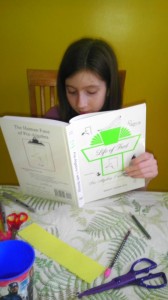 Another thing that is important to consider is your child’s strengths. My oldest daughter is a lot like me — literature and history minded. She loves to read and aspires to be a writer. She’ll spend hours at a time typing away at her laptop working on her latest story and is our resident mythologist. I can basically hand her a book list and let her go, and she’s happy as a clam.
Another thing that is important to consider is your child’s strengths. My oldest daughter is a lot like me — literature and history minded. She loves to read and aspires to be a writer. She’ll spend hours at a time typing away at her laptop working on her latest story and is our resident mythologist. I can basically hand her a book list and let her go, and she’s happy as a clam.
My twins are the total opposite. They are very good at math and science, but also very artistic. They are artists and musicians, so that is where I put a lot of focus for them. I want them to be literate too, so I try and choose literature that I think will inspire them, but I can’t use the same materials with them as I did with my daughter. It would be a disaster if I did. They spend hours everyday drawing and practicing their instruments, so I try to work art and music into their school day as much as possible.
My youngest daughter is a ball of raw energy, just constantly in motion. She loves to be outdoors and in the dirt, and she loves to do whatever her siblings are doing. She too, loves music and art, and can spend hours drawing some pretty intricate pictures.
So, how do I homeschool my individual children who are so different, without losing my mind?
This is where that big picture plan comes into play. I know that I want my children to be well rounded, to be well read and well spoken, and to be able to form their own thoughts and opinions. I can choose those materials that will support that. I want to give them a beautiful homeschool education, filled with ideas and heroes and time to just stew in their own thoughts. I also want to have family unity, so I try to do as much as I can with all of them together as possible.
You may be wondering what that looks like, on a day-to-day basis. This is just an example of an average day – with the caveat that there is no such thing as an average day. Everyday is different, but I try to keep to a certain rhythm, so that every day has a similar flow. I find we’re all happier when we know what to expect.
While the children are eating their breakfast, I quickly go over the day with them — remind them of anything different that might be happening, music lessons, soccer games, dentist appointments, etc. Then we do our morning time — we go over memory work, and I read aloud whatever our current book happens to be.
Then the children go upstairs and get dressed and do their morning chores while I clean 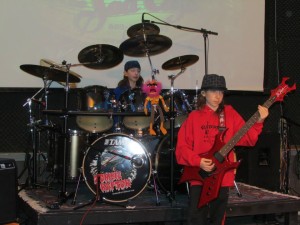 up from breakfast. The twins rotate music practice. They do an hour of guitar or drums first thing, while the other does math and copywork. Sometimes I’ll put a freewrite on the board, something creative and thought or humor provoking like “describe your favorite meal without telling what it is and the rest of us will try to figure it out.” or “make this a more interesting sentence: I went to the store and bought a toy.” These are more geared towards the twins, but my oldest will sometimes do them for fun as well.
up from breakfast. The twins rotate music practice. They do an hour of guitar or drums first thing, while the other does math and copywork. Sometimes I’ll put a freewrite on the board, something creative and thought or humor provoking like “describe your favorite meal without telling what it is and the rest of us will try to figure it out.” or “make this a more interesting sentence: I went to the store and bought a toy.” These are more geared towards the twins, but my oldest will sometimes do them for fun as well.
Meanwhile, I give my oldest daughter her checklist (we use Scholaric for planning our daily schedules and record-keeping) and we discuss what she needs to accomplish. She’s fairly independent at this point, but I check in with her throughout the day just to make sure she’s on task and answer any questions she might have. I also take this time to read a few picture books with my youngest. Sometimes I’ll take it further with her and we’ll do an art project to go along with the reading, but most days, it’s just reading.
When the twins have finished music practice, math and writing, we’ll have a spelling lesson. They are weak spellers, so we’ve been working through the Sequential Spelling books. If it’s a dictation day, this is when we’ll complete their dictation lesson. Then we read our history reading for the day and complete any writing or project that might go along with that.
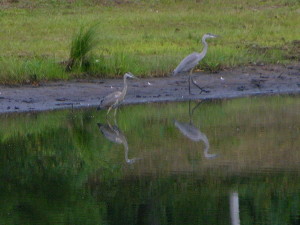 If the weather is nice, this is the point in our day where we might get outside for some fresh air and exercise, or do a bit of nature study. We have done a wide variety of activities over the years for nature study. Sometimes we’ll focus on one particular tree in the yard (each child will choose one tree) and they’ll study its change over the seasons. One year we focused on birds, another on bugs. Sometimes we’ll just look for things that strike our fancy and they might complete an entry in their nature journals.
If the weather is nice, this is the point in our day where we might get outside for some fresh air and exercise, or do a bit of nature study. We have done a wide variety of activities over the years for nature study. Sometimes we’ll focus on one particular tree in the yard (each child will choose one tree) and they’ll study its change over the seasons. One year we focused on birds, another on bugs. Sometimes we’ll just look for things that strike our fancy and they might complete an entry in their nature journals.
Around an hour later, it’s time for lunch. This is where I like to sneak in some fine arts. Sometimes I’ll read poetry, or we’ll do artist study and I’ll bring my laptop to the table so we can look at artwork and talk about our favorite pieces, or maybe I’ll just play some classical music (or any particular music that I want them to hear — I’ve been known to play Foo Fighters, The Doors or Jimi Hendrix or even Broadway show-tunes just to expose them to what we consider great music.)
After lunch, if it’s a science day, I’ll do a science lesson with the twins. Or we might do
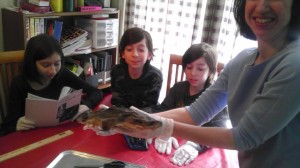
an art project. They rotate music practice again: while one is practicing, the other is doing their independent reading and narration work. I’ll check in with my oldest, and see if she need any help or has any questions. We’ll go over assignments, discuss what she’s reading, etc. We aim to have our school-day complete by 1 pm. Sometimes, for my high schooler, it’s more like 2 pm, depending on the day’s workload.
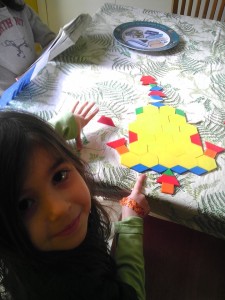 Then the kids have the rest of the day to just be. They might go outside and ride bikes or play with neighborhood friends or work on a project, or just sit and zone out. I don’t do much, academically with my youngest yet. She’s just turned 5, but she spends much of her day drawing pictures, practicing writing letters on the white board, or playing with manipulatives. She recently discovered my stash of pattern blocks which are her current favorite.
Then the kids have the rest of the day to just be. They might go outside and ride bikes or play with neighborhood friends or work on a project, or just sit and zone out. I don’t do much, academically with my youngest yet. She’s just turned 5, but she spends much of her day drawing pictures, practicing writing letters on the white board, or playing with manipulatives. She recently discovered my stash of pattern blocks which are her current favorite.
And that’s basically it. We read, we talk, we write, we make music and art, and we learn together. It get’s a bit more structured in the high school years, but only a little. The philosophy stays the same.
So when you feel the doubt creep in, or the tyranny of the urgent threatens to take over your day and you feel like what you’re doing isn’t enough, remember this: no one loves your child like you. No one has their best interest at heart more than you. So take a deep breath, remember that the big picture you painted of that beautiful education is possible, and know that you will be successful.
If you are looking for a structured literature based, secular homeschool curriculum, I hope you will try out one our our programs and join the Build Your Library family, – building young minds, one book at a time!
Current Full Grade Level Products Available for Purchase – Kindergarten – Grade 1 – Grade 2 – Grade 3 – Grade 4 – Grade 5 – Grade 6 – Grade 7 – Grade 8 – Grade 9 – Grade 10 (coming soon)
For Some Additional Educational Topics, Check Out Our Unit Studies Available for Purchase – Harry Potter and the Sorcerer’s Stone – History of Thanksgiving – A Jan Brett Christmas – The Hobbit – Darwin and Evolution – Sharks!
 Emily Cook is the author and creator of the secular homeschool curriculum Build Your Library, a literature-based K-12 program infused with the teachings of Charlotte Mason. She writes full year lesson plans as well as shorter topical unit studies. Emily has been homeschooling her four children in Southern NH for 21 years. She is passionate about reading aloud to children of all ages and loves to share her love of literature with others. She and her family also makes incredibly dorky videos about homeschooling, books and more on Youtube at ARRRGH! Schooling. You can follow her on Facebook, Twitter and Pinterest.
Emily Cook is the author and creator of the secular homeschool curriculum Build Your Library, a literature-based K-12 program infused with the teachings of Charlotte Mason. She writes full year lesson plans as well as shorter topical unit studies. Emily has been homeschooling her four children in Southern NH for 21 years. She is passionate about reading aloud to children of all ages and loves to share her love of literature with others. She and her family also makes incredibly dorky videos about homeschooling, books and more on Youtube at ARRRGH! Schooling. You can follow her on Facebook, Twitter and Pinterest.